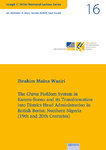- ISLAMWISSENSCHAFT
- ISLAMISCHE_STUDIEN
- JOSEPH C. MILLER MEMORIAL LECTURES SERIES
- ASIENWISSENSCHAFT
- ARCHÄOLOGIE ALS KULTURWISSENSCHAFT
- RELIGIONSWISSENSCHAFT
- RELIGIONSPÄDAGOGIK
- GESELLSCHAFT UND KIRCHE
- KIRCHE UND GEMEINDE
- GESUNDHEIT UND KRANKHEIT
- KINDERGARTENPÄDAGOGIK
- OPEN_ACCESS
- Neuerscheinungen
- In Vorbereitung
- News
- EBook
- Einzelkataloge
Categories JOSEPH C. MILLER MEMORIAL LECTURES SERIES Vol. 20: Virginia’s Eastern Shore and Edmund Scarburgh
Vol. 20: Virginia’s Eastern Shore and Edmund Scarburgh
Product no.: ISBN: 978-3-86893-456-4
In stock
can be shipped within 3 days
47 pages, paperback
14,8 x 21,0, 2023
English settler colonies introduced a new market structure to the Native peoples of the Chesapeake watershed. Alongside trade in goods, traders and merchants exchanged peoples for labor. The Eastern Shore of the Virginia colony provides an interesting case study that provides a clear picture of the importance of Native laborers alongside African and English laborers in the early plantation economy. Power dynamics in colonial Virginia were characterized by social hierarchies, economic interests, and the exercise of authority by influential individuals. By examining cases of illegal indenture and enslavement of Native peoples by Colonel Edmund Scarburgh in the 17th century, one can see that Scarburgh emerges as an unstoppable vigilante both at the time and in historical memory, because of his accumulation of wealth and power through the Indigenous slave trade as well as his transatlantic trade interests. Physically, and in many ways legally, isolated from the rest of the Virginia colony, the case study presented herein serves as a window into the power machinations and ambitions of one man and his desire to build his plantation empire unchecked by any conventions or rules of law.
The Author
Dr. Kristalyn Marie Shefveland is an Associate Professor of American History at the University of Southern Indiana. Her research focuses on settler memory and the Native South as well as the legacy of the Atlantic World. She is the author of Anglo-Native Virginia: Trade, Conversion, and Indian Slavery in the Old Dominion, 1646–1722 (University of Georgia Press, 2016) and Selling Vero Beach: Settler Myths in the Land of the Aís and Seminole (University of Florida Press, 2024).
We also recommend
|
E-Book-Version
|
Browse these categories as well: Categories, JOSEPH C. MILLER MEMORIAL LECTURES SERIES, Neuerscheinungen, Promotional Items






































